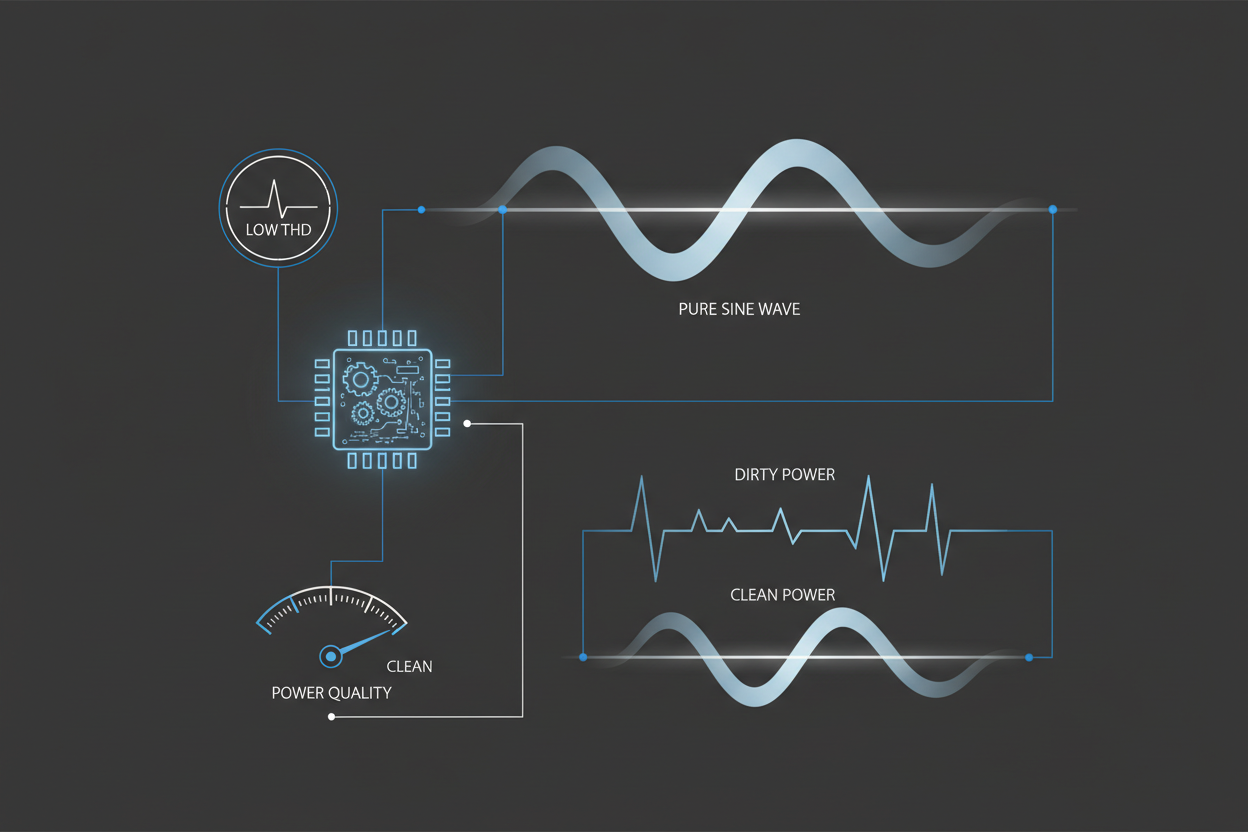Are Inverter Generators Better for Electronics?
Modern households depend on laptops, routers, TVs, and medical devices that all require clean, stable electricity. RV travelers and campers also power cameras, CPAP machines, and chargers away from the grid. These usage patterns raise an important question for buyers: do inverter generators truly protect electronics better than traditional generators? The answer is yes, because their digitally controlled output delivers low THD and pure sine wave power.
Understanding “Clean Power”
Electronic devices are designed to run on smooth waveforms with minimal distortion and very consistent voltage levels. The key measurement for power quality is THD (Total Harmonic Distortion), which compares real output against a perfect sine wave. You can learn more about distortion in our guide to THD in generators and the detailed waveform comparison in pure sine wave vs modified sine wave.
Inverter generators consistently maintain less than three percent THD, which is safe for sensitive electronics in homes and RVs. That level of cleanliness closely matches household utility power and greatly reduces long-term stress on internal circuits.
Why Traditional Generators Can Damage Electronics
Conventional generators create AC power directly from engine rotation without digital correction stages. When RPM fluctuates because of load changes or mechanical wear, voltage and frequency swing away from their ideal values.
These fluctuations can cause voltage spikes, frequency drift, and distorted “dirty power” waveforms that stress electronic power supplies. Common symptoms include phone or laptop battery damage, overheating chargers, flickering LEDs, CPAP malfunctions, and early failure of sensitive components. For electronics-heavy environments, traditional generators are rarely recommended.

How Inverter Generators Produce Stable Electricity
Protection advantages come from a three-stage conversion system built inside the inverter module. First the generator produces raw AC power from the engine, then converts that AC into DC through a rectifier stage.
- Generate raw AC power
- Convert AC to DC
- Reconstruct clean AC digitally
Digital electronics rebuild the DC into a clean sine wave with tightly controlled voltage and frequency. Because the final waveform is managed electronically instead of mechanically, power stays stable even when engine speed changes. You can see how this supports efficiency in our inverter generator efficiency guide.
Load Changes: Why Inverter Generators Stay Stable
Imagine plugging in a microwave while your laptop and router are already running on generator power. A traditional unit may sag, surge, or briefly drop voltage while the engine catches up to the new demand.
Such behavior can restart devices, overheat chargers, or momentarily distort waveforms feeding sensitive electronics. An inverter generator instead reacts within milliseconds using its control circuitry, boosting output while keeping voltage and frequency within safe limits. This fast response is critical for protecting modern electronics during everyday usage.
Why Low THD Matters for Device Safety
Devices built around microprocessors and switch-mode power supplies are extremely sensitive to dirty power. Laptops, tablets, televisions, routers, cameras, and medical devices rely on stable waveforms to regulate internal voltages correctly.
Clean sine wave output reduces heat, prevents unexpected shutdowns, and helps maintain long-term reliability. This is why manufacturers and RV technicians almost universally recommend inverter generators when powering sensitive electronics. For more background on this topic, see are inverter generators safe for electronics.
Does ECO Mode Affect Power Stability?
Some users worry that ECO mode might reduce power quality because the engine runs at lower RPM. That concern comes from experience with traditional generators, where speed changes directly affect output waveform and frequency.
Instead, inverter generators regulate power digitally, so sine wave reconstruction stays stable even when engine speed drops. ECO mode reduces noise and fuel use while the inverter module keeps voltage and frequency within tight limits. This means ECO mode does not reduce protection for sensitive electronics during light or moderate loads.
Real-World Use Cases Where Protection Matters Most
Inverter generator protection becomes especially important for RV travelers charging laptops, cameras, drones, and networking gear on the road. Their rigs often combine residential-style appliances with delicate electronics that all share the same power source. For more RV-specific guidance, visit the RV Generator Guide.
That same protection also benefits homeowners powering routers, modems, LED TVs, and work-from-home equipment during outages. Campers running CPAP machines or charging high-value photography gear likewise gain peace of mind from cleaner power. You can explore these outdoor scenarios further inside our Camping Generator Guide and backup strategies in the Home Backup Generator Guide.
Conclusion
Ultimately, inverter generators do protect electronics better than traditional models in nearly every real-world scenario. Their digitally controlled output, low THD, and rapid response to load changes make them the safest choice for laptops, medical devices, entertainment systems, and networking hardware.
Readers who want a deeper technical breakdown of inverter technology, THD, and clean power can continue with the full Inverter Generator Guide.
